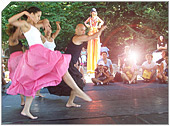Hamilton Heights
, Manhattan, New York City
|
Getting Started
Index
NYC Neighborhoods
Manhattan
Brooklyn
Queens
Bronx
Staten Island
NYC Icons
Chrysler Building
Flatiron Building
Empire State Building
Safe NYC
NYPD
FDNY
NYC Weather
NYC Climate
NYC Weather Forecast
Winter Season
Spring Season
Summer Season
Fall Season
NYC History & Politics
New York City History
Tammany Hall and Politics
New York City Politicians
New York City Personalities
Culture of Gotham City
Culture of the city
Cultural diversity
City in popular culture
|
Hamilton Heights is a neighborhood in the New York City borough of Manhattan. It lies between Washington Heights and Manhattanville, Manhattan/Manhattanville, Morningside Heights; it includes the neighborhood of Sugar Hill, and is itself often considered part of Harlem.
It is bounded by 135th Street to the south, the Hudson River to the west, 155th Street to the north, and Saint Nicholas Avenue/Bradhurst Avenue to the east. The community derives its name from Founding Father Alexander Hamilton, who lived the last two years of his life in the area when it was still largely farmland; specifically, he lived in what is now known as Hamilton Grange National Monument. It is located within Manhattan Community Board 9.
Most of the housing dates from the extension of the Elevated and Subway lines at the end of the 19th and the start of the 20th Centuries. This fairly elegant housing became less desirable to the original White residents in the 1930s and 1940s as the population changed from White to Black, even though the black residents were just as affluent as the white residents. These are beautiful and spacious apartment buildings, magnificent brownstones and stately row houses prominently lining the leafy eastern streets of Hamilton Heights, an area traditionally home to a substantial black professional class. Today the local population is changing again, with Hispanics and Latinos constituting a majority of the population followed by African Americans, peoples from the Spanish Antilles; the West Indies and remainders of earlier time's ethnic whites.
The brownstone revival of the 1960s and 1970s led to a new movement of middle-class blacks in the area. The Latinos arrived in large numbers in the 1980s - with Dominicans making up the majority. Gentrification since 2005 has drastically increased the proportion of non-Hispanic whites, LGBTQ, and Asian residents. It is the home of the City College of New York (CCNY), Dance Theatre of Harlem, The Harlem School of the Arts, Aaron Davis Hall, an amazing dollar store, Hamilton Palace (a department store), both intended for low income consumers, a Botánica, C Town, bodegas, hair salons and barber shops.
The neighborhood offers several parks, including the very modern Riverbank State Park, around which Riverside Park winds its way to Washington Heights and the historic St. Nicholas Park.
Historic Hamilton Heights comprises the Hamilton Heights Historic District and the Hamilton Heights/Sugar Hill Historic District Extension, both designated by the New York City Landmarks Preservation Commission. One of the highest hills in Hamilton Heights slopes up from the Hudson River at 155th Street, and contains the Trinity Church Cemetery.
The neighborhood is easily accessed via subway, the number 1 line stops at the 137th Street-City College and 145th Street stations. The famous A train on St. Nicholas Avenue provides service at145th Street. The C train services 135th Street, 145 Street and 155th street and Saint Nicholas Avenue.
The MTA-New York City Transit bus lines M4 and M5 serve Broadway, M100 and M101 run on Amsterdam Avenue, M18 on Convent Avenue; M11 on 135th Street; Bx19 on 145th Street; Bx6 on 155th Street and the M3 on St. Nicholas Avenue.
|
New York City Search
Quick NYC
|
|
|
 How safe is New York City?
How safe is New York City? Contrary to popular belief, the City consistantly ranks in the top ten safest large cities in the United States. The NYPD is the largest municipal police force in the world and has it's own Movie/TV Unit. |

New York has a humid continental climate resulting from prevailing wind patterns that bring cool air from the interior of the North American continent. New York winters are typically cold with moderate snowfall.  New York Weather Forecast New York Weather Forecast |

New York's two key demographic features are its density and diversity. The New York City metropolitan area is home to the largest Jewish community outside Israel. It is also home to nearly a quarter of the nation's South Asians, and the largest African American community of any city in the country.  Ethnic composition Ethnic composition |

New York Newspapers
 
|



 New York Weather Forecast
New York Weather Forecast
 Ethnic composition
Ethnic composition


















